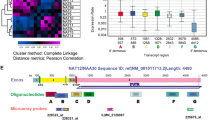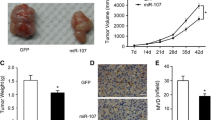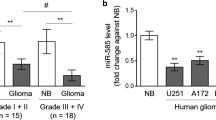Abstract
Methionine aminopeptidases (MetAPs) have been pharmacologically linked to cell growth, angiogenesis, and tumor progression, which make it an attractive target for cancer therapy. We investigated MetAP2’s biological role in glioblastoma (GBM), an aggressive tumor characterized by massive neovascularization. We examined the effect of anti-MetAP2 RNA interference on proliferation and angiogenesis in GBM cell line. The biological effects of MetAP2 knockdown were assessed by comparing the proliferation, tumorigenecity, and angiogenesis of parental cells and MetAP2 knockdown cells. We generated MetAP2 knockdown cells using lentiviral short hairpin RNAs against MetAP2 in SNB19 GBM cells, which normally express high levels of MetAP2. MetAP2 knockdown cells were less proliferative and less tumorigenic when compared to the parental cells. MetAP2 knockdown decreased vascular endothelial growth factor (VEGF) secretion and expression at the mRNA and protein levels. Decreased VEGF expression in MetAP2 knockdown cells correlated very well with decreased vessel formation in a tube formation assay. We showed that VEGF suppression in MetAP2 knockdown cells was mediated by the von Hippel-Lindau protein. In in vivo animal studies using an intracranial SNB19 tumor model, MetAP2 knockdown also reduced the tumor growth rate and angiogenesis, which in turn prolonged the survival of mice in xenograft model. Our results show that MetAP2 regulates angiogenesis in GBM and identify MetAP2-specific substrates that may serve as candidates for clinical assay development.






Similar content being viewed by others
References
Louis DN, Perry A, Reifenberger G, von Deimling A, Figarella-Branger D, Cavenee WK, Ohgaki H, Wiestler OD, Kleihues P, Ellison DW (2016) The 2016 World Health Organization classification of tumors of the central nervous system: a summary. Acta Neuropathol 131:803–820. https://doi.org/10.1007/s00401-016-1545-1
Holland EC (2000) Glioblastoma multiforme: the terminator. Proc Natl Acad Sci USA 97:6242–6244
Maher EA, Furnari FB, Bachoo RM, Rowitch DH, Louis DN, Cavenee WK, DePinho RA (2001) Malignant glioma: genetics and biology of a grave matter. Genes Dev 15:1311–1333
Lee OH, Fueyo J, Xu J, Yung WK, Lemoine MG, Lang FF, Bekele BN, Zhou X, Alonso MA, Aldape KD, Fuller GN, Gomez-Manzano C (2006) Sustained angiopoietin-2 expression disrupts vessel formation and inhibits glioma growth. Neoplasia (New York NY) 8:419–428
Wechsler-Reya R, Scott MP (2001) The developmental biology of brain tumors. Annu Rev Neurosci 24:385–428
Stupp R, Mason WP, van den Bent MJ, Weller M, Fisher B, Taphoorn MJ, Belanger K, Brandes AA, Marosi C, Bogdahn U, Curschmann J, Janzer RC, Ludwin SK, Gorlia T, Allgeier A, Lacombe D, Cairncross JG, Eisenhauer E, Mirimanoff RO (2005) Radiotherapy plus concomitant and adjuvant temozolomide for glioblastoma. N Engl J Med 352:987–996
Davis FG, McCarthy BJ, Freels S, Kupelian V, Bondy ML (1999) The conditional probability of survival of patients with primary malignant brain tumors: surveillance, epidemiology, and end results (SEER) data. Cancer 85:485–491
Giese A, Bjerkvig R, Berens ME, Westphal M (2003) Cost of migration: invasion of malignant gliomas and implications for treatment. J Clin Oncol 21:1624–1636
Datta B (2000) MAPs and POEP of the roads from prokaryotic to eukaryotic kingdoms. Biochimie 82:95–107
Bradshaw RA, Brickey WW, Walker KW (1998) N-terminal processing: the methionine aminopeptidase and N alpha-acetyl transferase families. Trends Biochem Sci 23:263–267
Resh MD (2004) Membrane targeting of lipid modified signal transduction proteins. Subcell Biochem 37:217–232
Varshavsky A (2005) Regulated protein degradation. Trends Biochem Sci 30:283–286
Bernier SG, Taghizadeh N, Thompson CD, Westlin WF, Hannig G (2005) Methionine aminopeptidases type I and type II are essential to control cell proliferation. J Cell Biochem 95:1191–1203
Yeh JR, Ju R, Brdlik CM, Zhang W, Zhang Y, Matyskiela ME, Shotwell JD, Crews CM (2006) Targeted gene disruption of methionine aminopeptidase 2 results in an embryonic gastrulation defect and endothelial cell growth arrest. Proc Natl Acad Sci USA 103:10379–10384
Tucker LA, Zhang Q, Sheppard GS, Lou P, Jiang F, McKeegan E, Lesniewski R, Davidsen SK, Bell RL, Wang J (2008) Ectopic expression of methionine aminopeptidase-2 causes cell transformation and stimulates proliferation. Oncogene 27:3967–3976. https://doi.org/10.1038/onc.2008.14
Selvakumar P, Lakshmikuttyamma A, Kanthan R, Kanthan SC, Dimmock JR, Sharma RK (2004) High expression of methionine aminopeptidase 2 in human colorectal adenocarcinomas. Clin Cancer Res 10:2771–2775
Datta B, Datta R (1999) Induction of apoptosis due to lowering the level of eukaryotic initiation factor 2-associated protein, p67, from mammalian cells by antisense approach. Exp Cell Res 246:376–383
Sheen IS, Jeng KS, Jeng WJ, Jeng CJ, Wang YC, Gu SL, Tseng SY, Chu CM, Lin CH, Chang KM (2005) Fumagillin treatment of hepatocellular carcinoma in rats: an in vivo study of antiangiogenesis. World J Gastroenterol 11:771–777
Ho CY, Bar E, Giannini C, Marchionni L, Karajannis MA, Zagzag D, Gutmann DH, Eberhart CG, Rodriguez FJ (2013) MicroRNA profiling in pediatric pilocytic astrocytoma reveals biologically relevant targets, including PBX3, NFIB, and METAP2. Neuro Oncol 15:69–82. https://doi.org/10.1093/neuonc/nos269
Jia J, Yang F, Yang M, Wang C, Song Y (2016) P38/JNK signaling pathway mediates the fluoride-induced down-regulation of Fam83h. Biochem Biophys Res Commun 471:386–390. https://doi.org/10.1016/j.bbrc.2016.02.027
Koul D, Jasser SA, Lu Y, Davies MA, Shen R, Shi Y, Mills GB, Yung WK (2002) Motif analysis of the tumor suppressor gene MMAC/PTEN identifies tyrosines critical for tumor suppression and lipid phosphatase activity. Oncogene 21:2357–2364. https://doi.org/10.1038/sj.onc.1205296
Yamamura H, Suzuki Y, Asai K, Imaizumi Y (2016) Hypoxic stress up-regulates Kir2.1 expression and facilitates cell proliferation in brain capillary endothelial cells. Biochem Biophys Res Commun 476:386–392. https://doi.org/10.1016/j.bbrc.2016.05.131
Lal S, Lacroix M, Tofilon P, Fuller GN, Sawaya R, Lang FF (2000) An implantable guide-screw system for brain tumor studies in small animals. J Neurosurg 92:326–333. https://doi.org/10.3171/jns.2000.92.2.0326
Gomez-Manzano C, Fueyo J, Jiang H, Glass TL, Lee HY, Hu M, Liu JL, Jasti SL, Liu TJ, Conrad CA, Yung WK (2003) Mechanisms underlying PTEN regulation of vascular endothelial growth factor and angiogenesis. Ann Neurol 53:109–117
Mukhopadhyay D, Knebelmann B, Cohen HT, Ananth S, Sukhatme VP (1997) The von Hippel-Lindau tumor suppressor gene product interacts with Sp1 to repress vascular endothelial growth factor promoter activity. Mol Cell Biol 17:5629–5639
Bernier SG, Lazarus DD, Clark E, Doyle B, Labenski MT, Thompson CD, Westlin WF, Hannig G (2004) A methionine aminopeptidase-2 inhibitor, PPI-2458, for the treatment of rheumatoid arthritis. Proc Natl Acad Sci USA 101:10768–10773. https://doi.org/10.1073/pnas.0404105101
Hannig G, Bernier SG, Hoyt JG, Doyle B, Clark E, Karp RM, Lorusso J, Westlin WF (2007) Suppression of inflammation and structural damage in experimental arthritis through molecular targeted therapy with PPI-2458. Arthritis Rheum 56:850–860. https://doi.org/10.1002/art.22402
Selvakumar P, Lakshmikuttyamma A, Das U, Pati HN, Dimmock JR, Sharma RK (2009) NC2213: a novel methionine aminopeptidase 2 inhibitor in human colon cancer HT29 cells. Mol Cancer 8:65. https://doi.org/10.1186/1476-4598-8-65
Majumdar A, Ghosh A, Datta S, Prudner BC, Datta B (2010) p67/MetAP2 suppresses K-RasV12-mediated transformation of NIH3T3 mouse fibroblasts in culture and in athymic mice. BioChemistry 49:10146–10157. https://doi.org/10.1021/bi101225d
Lowther WT, Matthews BW (2000) Structure and function of the methionine aminopeptidases. Biochim Biophys Acta 1477:157–167
Wang J, Lou P, Henkin J (2000) Selective inhibition of endothelial cell proliferation by fumagillin is not due to differential expression of methionine aminopeptidases. J Cell Biochem 77:465–473
Wu S, Gupta S, Chatterjee N, Hileman RE, Kinzy TG, Denslow ND, Merrick WC, Chakrabarti D, Osterman JC, Gupta NK (1993) Cloning and characterization of complementary DNA encoding the eukaryotic initiation factor 2-associated 67-kDa protein (p67). J Biol Chem 268:10796–10801
Kanno T, Endo H, Takeuchi K, Morishita Y, Fukayama M, Mori S (2002) High expression of methionine aminopeptidase type 2 in germinal center B cells and their neoplastic counterparts. Lab Invest 82:893–901
Chun E, Han CK, Yoon JH, Sim TB, Kim YK, Lee KY (2005) Novel inhibitors targeted to methionine aminopeptidase 2 (MetAP2) strongly inhibit the growth of cancers in xenografted nude model. Int J Cancer 114:124–130
Catalano A, Romano M, Robuffo I, Strizzi L, Procopio A (2001) Methionine aminopeptidase-2 regulates human mesothelioma cell survival: role of Bcl-2 expression and telomerase activity. Am J Pathol 159:721–731
Zhao Y, Zhou Y, KM OB, Murphy PV (2010) Biological study of the angiogenesis inhibitor N-(8-(3-ethynylphenoxy)octyl-1-deoxynojirimycin. Chem Biol Drug Des 75:570–577. https://doi.org/10.1111/j.1747-0285.2010.00968.x
Zhang Y, Zhang N, Dai B, Liu M, Sawaya R, Xie K, Huang S (2008) FoxM1B transcriptionally regulates vascular endothelial growth factor expression and promotes the angiogenesis and growth of glioma cells. Cancer Res 68:8733–8742
Griffith EC, Su Z, Turk BE, Chen S, Chang YH, Wu Z, Biemann K, Liu JO (1997) Methionine aminopeptidase (type 2) is the common target for angiogenesis inhibitors AGM-1470 and ovalicin. Chem Biol 4:461–471
Ingber D, Fujita T, Kishimoto S, Sudo K, Kanamaru T, Brem H, Folkman J (1990) Synthetic analogues of fumagillin that inhibit angiogenesis and suppress tumour growth. Nature 348:555–557. https://doi.org/10.1038/348555a0
Kusaka M, Sudo K, Matsutani E, Kozai Y, Marui S, Fujita T, Ingber D, Folkman J (1994) Cytostatic inhibition of endothelial cell growth by the angiogenesis inhibitor TNP-470 (AGM-1470). Br J Cancer 69:212–216
Feldkamp MM, Lau N, Rak J, Kerbel RS, Guha A (1999) Normoxic and hypoxic regulation of vascular endothelial growth factor (VEGF) by astrocytoma cells is mediated by Ras. Int J Cancer 81:118–124
Kwon YT, Kashina AS, Davydov IV, Hu RG, An JY, Seo JW, Du F, Varshavsky A (2002) An essential role of N-terminal arginylation in cardiovascular development. Science 297:96–99
Sikora S, Godzik A (2004) Combination of multiple alignment analysis and surface mapping paves a way for a detailed pathway reconstruction: the case of VHL (von Hippel-Lindau) protein and angiogenesis regulatory pathway. Protein Sci 13:786–796
Author information
Authors and Affiliations
Corresponding author
Ethics declarations
Conflict of interest
The authors report no conflict of interest.
Ethical approval
All applicable international, national, and/or institutional guidelines for the care and use of animals were followed.
Rights and permissions
About this article
Cite this article
Lin, M., Zhang, X., Jia, B. et al. Suppression of glioblastoma growth and angiogenesis through molecular targeting of methionine aminopeptidase-2. J Neurooncol 136, 243–254 (2018). https://doi.org/10.1007/s11060-017-2663-x
Received:
Accepted:
Published:
Issue Date:
DOI: https://doi.org/10.1007/s11060-017-2663-x




